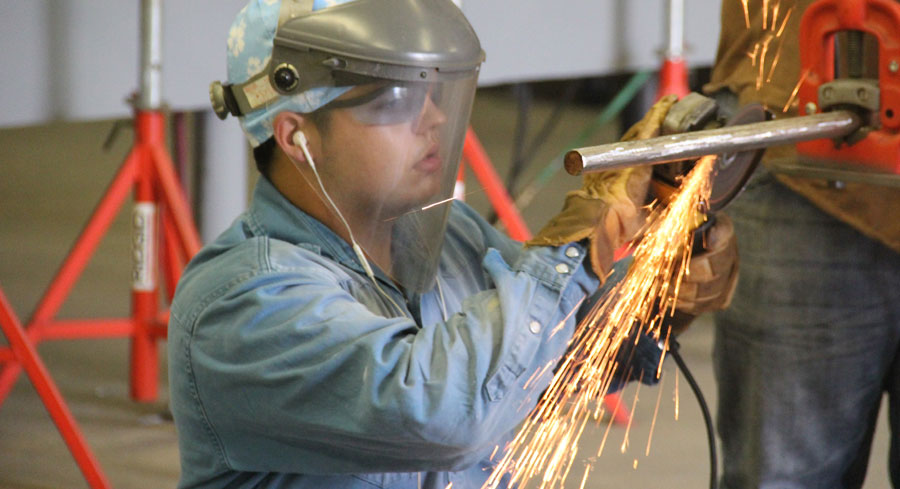Welding – Dual Credit

About the Career
Working with artistic precision, welders possess high-level skills that many companies compete to employ.
Median hourly pay: $17.93
Source: Texas Workforce Commission
Job Market and Salary
| Welding | Average Median Salary | Percentage of Growth by 2022 |
|---|---|---|
| Gulf Coast Region | $37,294 | 20-29% (2012-2022) |
| Texas | $37,294 | 20.4% |
| National | $37,294 | 20% |
About the Program
In these classes you will discover the properties of metals, welding symbols, electrical principles, blueprint reading and mechanical drawing. After completing the Entry-Level Welding Certificate, students can take a certification test to receive a Certified Entry-Level Welder Certification from the American Welding Society.
Contact Information
Please speak with the dual credit advisor or college connection advisor at your high school.
Welding Certificate
-
WLDG 1421 – Introduction to Welding Fundamentals
This is an introduction to the fundamentals of equipment used in oxyacetylene and arc welding, including welding and cutting safety, basic oxyacetylene welding and cutting, basic arc welding processes and basic metallurgy. Students will demonstrate safety procedures associated with oxyacetylene and arc process; perform basic welds using oxyacetylene and arc welding equipment; and identify ferrous and nonferrous metals.
-
WLDG 1425 – Introduction to OXY-Fuel Welding and Cutting
This is an introduction to oxy-fuel welding and cutting, including history and future in welding, safety, setup and maintenance of oxy-fuel welding, and cutting equipment and supplies. Students will describe or explain oxy-fuel welding and cutting safety procedures and identify and classify fuels and filler metals. Students will perform entry-level oxy-fuel welding and cutting operations and select proper equipment and materials.
-
WLDG 1457 – Intermediate Shielded Metal Arc Welding (SMAW)
This is a study of the production of various fillets and groove welds. Students will prepare specimens for testing in all test positions. Students will identify principles of arc welding; describe arc welding operations of fillet and groove joints; explain heat treatments of low alloy steels; and explain weld size and profiles. The student will prepare test plates; perform fillet welds in the overhead position; perform air carbon arc weld removal; perform bevel groove welds with backing plates in various positions; and demonstrate use of tools and equipment.
Prerequisite or co-requisite: WLDG 1421.
-
WLDG 1434 – Introduction to Gas Tungsten Arc (GTAW) Welding
This course is an introduction to the principles of gas tungsten arc welding (GTAW), setup and use of GTAW equipment, and safe use of tools and equipment. Welding instruction in various positions on joint designs. Students will describe various joint designs; describe safety rules and equipment; and describe the effects of welding parameters in GTAW; and will weld various structural materials.
-
WLDG 1430 – Introduction to Gas Metal Art (GMAW) Welding
This course studies the principles of gas metal arc welding, setup and use of GMAW equipment, and safe use of tools/ equipment. Instruction focuses on various joint designs. Students will describe welding positions with various joint designs on plate; describe safety rules and equipment used; describe the effects of welding parameters in GMAW; and understand safety rules, equipment used, and testing performed by visual inspection. Students will weld various types of structural material and diagnose welding problems and perform visual inspections.
-
WLDG 1435 – Introduction to Pipe Welding
This is an introduction to welding of pipe using the shielded metal arc welding process, including electrode selection, equipment setup, and safe shop practices. Emphasis is placed on weld positions 1G and 2G using various electrodes. Students will describe equipment and require pipe preparation and perform 1G and 2G welds using various electrodes.
Prerequisite or co-requisite: WLDG 1457.
Schedule
| Semester | Course | Credit Hours Contact Hours |
Days | Times | Tuition (In/Out District) |
|---|---|---|---|---|---|
| Year 1 – Fall | WLDG 1421 | 4 / 112 | Monday – Thursday | 7 – 8:45 / 1:30 – 3:15 | $200 / $250 + supply fee |
| Year 1 – Spring | WLDG 1425 | 4 / 112 | Monday – Thursday | 7 – 8:45 / 1:30 – 3:15 | $200 / $250 + supply fee |
| Year 2 – Fall | WLDG 1457 | 4 / 112 | Monday – Thursday | 7 – 8:45 / 1:30 – 3:15 | $200 / $250 + supply fee |
| Year 2 – Spring | WLDG 1434 | 4 / 112 | Monday – Thursday | 7 – 8:45 / 1:30 – 3:15 | $200 / $250 + supply fee |
TSI Assessment: Not needed for certificates.
- Equipment, textbook and workbook used through entire program.
- Equipment: ($150) must be purchased through AirGas to start program.
- Textbook: Welding Principles and Applications ($167.75) must be purchased to start program.
- Lab Manual: Welding Principles and Applications ($97.25) must be purchased to start program.
Credential: Employable, but two courses (8 hours) shy of Entry Level Welding certificate.
COM Next Steps – Stackable Credentials:
- Complete WLDG 1430 & WLDG 1435 to obtain Entry Level Welding Certificate
- Complete WLDG 1412, WLDG 2451, WLDG 2406 & WLDG 2413 to obtain Advanced Level Welding Certificate
After completing the Advanced-Level Welding Certificate, student will take a certification test on QC11. Upon passing the exam, student will receive an Advanced Certification from the American Welding Society (AWS). The AWS certificate is verification of workplace competencies in the area of Advanced-Level Welding.
